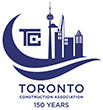The Importance of the Building Envelope
In the last article in our building sciences series, we talked about the Ontario Building Code - this time, we’re going to cover the building envelope and what it is, why it’s important, and how it’s applied in your home.
Simply put, the building envelope is the materials used to separate the environment from the interior of your home. Some parts of it are self-evident: the walls, your roof, and the floor of your home are all key parts of the building envelope. But it’s the makeup and functioning of these parts (and the layers between them) that truly make a successful building envelope.
Vapour Barrier Systems
One important part of your building envelope is a vapour barrier. The vapour barrier protects your home from unwanted moisture and water in your floors, walls, attic, and roof. The Ontario Building Code specifies a number of different types of vapour barrier:
- polyethylene and other membrane type vapour barriers
- vapour barrier paints
- foam plastic vapour barriers
To work efficiently, a vapour barrier needs to be installed correctly, or else it may cause damage or fail. A vapour barrier needs to be:
- installed on the warm side of the wall, floor, or ceiling
- installed close enough to the insulation to prevent condensation
Air Barrier Systems
Equally as important to the vapour barrier in your building envelope is your air barrier system. These products and materials prevent unwanted air flow and leakage from the interior of your home to the exterior. The air barrier helps to:
- prevent moisture condensation
- ensure a comfortable indoor environment
- minimize soil gasses moving into the interior
How This Looks in Your Home
With effective air and vapour barriers as part of your building envelope, your home will run more efficiently and require less work to maintain. While applying air and moisture barriers to exterior walls is straightforward, the Ontario Building Code gives specific guidance on where and how you need to protect heated and unheated spaces.
Garages: Even if you intend on heating your garage, your home still needs to be treated as a separate space, with adequate barriers separating the two.
Walkout Basements: The exterior wall on any walkout basement with an exposed area of greater than 50% must have the same level of thermal performance as above grade walls, especially the wall contains an exterior door.
Rims and Headers: Insulation needs to be provided in the rim joints and header areas where your floor and wall meet; this insulation must be the same or more than what is required for above grade walls.
Thermal Bridges: You may remember from our article titled “How Can Insulation Prevent Heat Loss?” that a thermal bridge is an area or material in your home that has a higher rate of heat transfer. For example, the Building Code requires that wood studs framing an area of less thermal resistance be insulated to restrict heat flow.
Foundation Walls: One of the most important areas of your building envelope is your foundation. When the foundation encloses conditioned spaces it must be insulated to 8” above the floor (to prevent damage in case of flooding), and if your slab contains ducts, pipes or other tubes or cables it also must be correctly insulated.
Attic Hatches: The attic is one of the few areas the code specifies that insulation can be reduced. Directly above the attic hatch is one, and near the eaves is the other.
Renovating Your Home
What if you have an old home and are thinking about renovating or adding an addition? How can you ensure your home and building envelope complies with the Ontario Building Code? Guidance for homeowners and contractors such as EcoStar are provided within the code itself, specifying what software may be used to model homes, and providing reports that help determine the required insulation for the climate the home is situated within. Tables and charts will help you and your contractor decide what type of thermal performance requirements apply to your home, and for additions, whether or not they need to be considered independently of existing structures.
Choosing the Best for Your Home
When it comes to addressing the building envelope and renovating your home to make it more efficient, you can trust the experts at EcoStar Insulation to help you get it right. As you may have already guessed, insulation plays a huge role in an effective building envelope. Spray foam insulation is our top choice for new builds and retrofits because it acts as both an air and vapour barrier in one while providing excellent R-Values and insulating power. With nearly a decade of experience working with insulation and the Ontario Building Code, the teams at EcoStar Insulation have the practical knowledge and skills to make installation easy. For more information about the building envelope and the products and services we offer, get in touch at 1-866-789-1536 or online at www.ecostarinsulation.ca.



